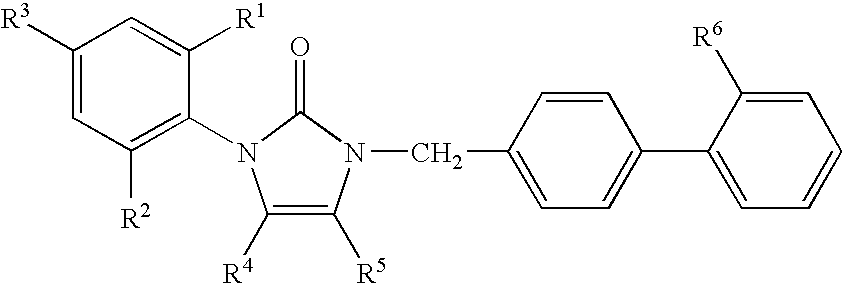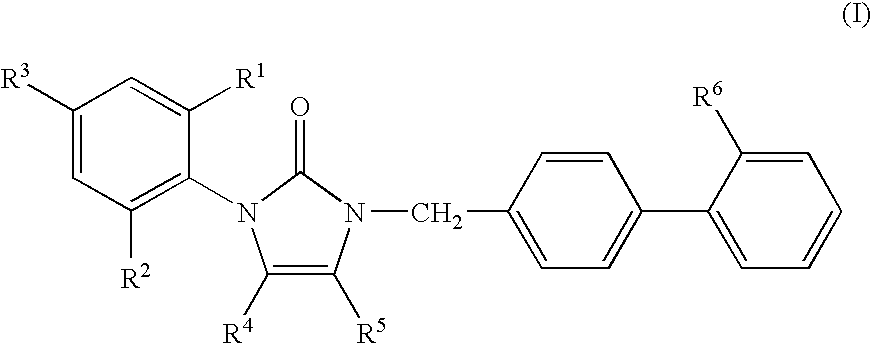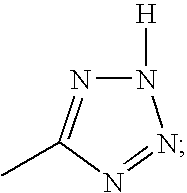1-phenyl imidazol-2-one biphenylmethyl compounds for treatment of circulatory disorders
a technology of biphenylmethyl compounds and phenyl imidazol, which is applied in the direction of biocide, cardiovascular disorders, drug compositions, etc., can solve the problems of limited use of peptidic compounds and limit their therapeutic application
- Summary
- Abstract
- Description
- Claims
- Application Information
AI Technical Summary
Problems solved by technology
Method used
Image
Examples
example 1
1-(2-ethylphenyl)-4-butyl-1,3-dihydro-3-[2′-(1H-tetrazol-5-yl)[1,1′-biphenyl]-4-ylmethyl]-2H-imidazol-2-one
Step 1: Preparation of N-Triphenylmethyl-5-[2-(4′-bromomethylbiphen-2-yl]tetrazole.
A 542.5 g (2.4 mol) sample of methyl 2-(p-tolyl)benzoate (Chemo Dynamics Inc.) was dissolved in 5.5 L of ethanol and treated with 3 L (7.5 mol) of 2.5 N sodium hydroxide. The reaction was stirred overnight at ambient temperature and treated with an additional 480 ml (6.0 mol) of sodium hydroxide; stirring was continued for an additional 24 h and the ethanol removed in vacuo. The remaining solution was cooled in ice and acidified to pH 1 with hydrochloric acid which caused the product to precipitate; filtration and drying in vacuo gave 510 g (100%) of crude 2-(p-tolyl)benzoic acid: mp 145.0-147.5° C.; NMR (CDCl3) δ 2.40 (s, 3H), 7.17-7.28 (m, 4H), 7.35-7.45 (m, 2H), 7.51-7.59 (m, 1H), 7.90-7.97 (m, 1H). The crude acid was suspended in 1 L of toluene and slowly treated with 400 g (3.15 mol) of oxal...
example 2
1-(2-isopropylphenyl)-4-butyl-1,3-dihydro-3-[2′-(1H-tetrazol-5-yl)[1,1′-biphenyl]-4-ylmethyl]-2H-imidazol-2-one
Step 1: Preparation of 1-(2-isopropylphenyl)-4-butyl-1,3-dihydro-2H-imidazol-2-one.
Following General Synthetic Scheme III, 1-(2-isopropylphenyl)-4-butyl-1,3-dihydro-2H-imidazol-2-one was prepared: NMR (CDCl3) δ 0.89 (t, J=7 Hz, 3H), 1.21 (d, J=7 Hz, 6H), 1.30-1.44 (m, 2H), 1.48-1.60 (m, 2H), 2.38 (t, J=7 Hz, 2H), 3.05 (m, J=7 Hz, 1H), 5.93-5.96 (m, 1H), 7.17-7.42 (m, 4H), 10.65 (br s, 1H); MS (FAB) m / e (rel intensity) 259 (100); HRMS. Calc'd for M+H: 259.1810. Found: 259.1799.
Step 2: Preparation of 1-(2-isopropylphenyl)-4-butyl-1,3-dihydro-3-[2′-(1H-tetrazol-5-yl)[1,1′-biphenyl]-4-ylmethyl]-2H-imidazol-2-one.
Following General Synthetic Scheme VI, the imidazol-2-one from Step 1 was converted to 1-(2-isopropylphenyl)-4-butyl-1,3-dihydro-3-[2′-(1H-tetrazol-5-yl)[1,1′-biphenyl]-4-ylmethyl]-2H-imidazol-2-one as a colorless solid: mp 167-168° C.; NMR (CDCl3) δ 0.82 (t, J=7 Hz, 3H...
example 3
1-(2,6-dimethoxyphenyl)-4-butyl-1,3-dihydro-3-[2′-(1H-tetrazol-5-yl)[1,1′-biphenyl]-4-ylmethyl]-2H-imidazol-2-one
Step 1: Preparation of 1-(2,6-dimethoxyphenyl)-4-butyl-1,3-dihydro-2H-imidazol-2-one.
Following General Synthetic Scheme III, 1-(2,6-dimethylyphenyl)-4-butyl-1,3-dihydro-2H-imidazol-2-one was prepared: NMR (DMSO-d6) δ 0.89 (t, J=8 Hz, 3H), 1.27-1.40 (m, 2H), 1.42-1.57 (m, 2H), 2.26 (t, J=8 Hz, 2H), 3.71 (s, 6H), 5.91 (t, J=1 Hz, 1H), 6.72 (d, J=8 Hz, 2H), 7.31 (t, J=8 Hz, 2H), 9.85 (br s, 1H).
Step 2: Preparation of 1-(2,6-dimethoxyphenyl)-4-butyl-1,3-dihydro-3-[2′-(1H-tetrazol-5-yl)[1,1′-biphenyl]-4-ylmethyl]-2H-imidazol-2-one.
Following General Synthetic Scheme VI, the imidazol-2-one from Step 1 was converted to 1-(2,6-dimethoxyphenyl)-4-butyl-1,3-dihydro-3-[2′-(1H-tetrazol-5-yl)[1,1′-biphenyl]-4-ylmethyl]-2H-imidazol-2-one as a colorless solid: mp 189-191° C. (dec); NMR (DMSO-d6) δ 0.81 (t, J=7 Hz, 3H), 1.20-1.44 (m, 4H), 2.22 (t, J=7 Hz, 2H), 3.74 (s, 6H), 4.80 (s, 2H), ...
PUM
| Property | Measurement | Unit |
|---|---|---|
| Molar density | aaaaa | aaaaa |
| Molar density | aaaaa | aaaaa |
| Molar density | aaaaa | aaaaa |
Abstract
Description
Claims
Application Information
 Login to View More
Login to View More - R&D
- Intellectual Property
- Life Sciences
- Materials
- Tech Scout
- Unparalleled Data Quality
- Higher Quality Content
- 60% Fewer Hallucinations
Browse by: Latest US Patents, China's latest patents, Technical Efficacy Thesaurus, Application Domain, Technology Topic, Popular Technical Reports.
© 2025 PatSnap. All rights reserved.Legal|Privacy policy|Modern Slavery Act Transparency Statement|Sitemap|About US| Contact US: help@patsnap.com



